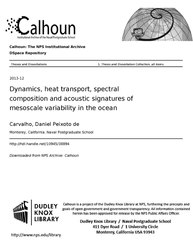File:Dynamics, heat transport, spectral composition and acoustic signatures of mesoscale variability in the ocean (IA dynamicsheattran1094538894).pdf

Original file (1,275 × 1,650 pixels, file size: 8.06 MB, MIME type: application/pdf, 80 pages)
Captions
Captions
Summary[edit]
| Dynamics, heat transport, spectral composition and acoustic signatures of mesoscale variability in the ocean
( |
||
|---|---|---|
| Author |
Carvalho, Daniel Peixoto de |
|
| Title |
Dynamics, heat transport, spectral composition and acoustic signatures of mesoscale variability in the ocean |
|
| Publisher |
Monterey, California. Naval Postgraduate School |
|
| Description |
The general circulation of the global ocean is turbulent rather than laminar. Mesoscale eddies contribute to the transport of tracers like heat, salt, and oxygen, and affect large-scale ocean dynamics. The problem of representing mesoscale variability stems from the nonlinear character of eddy dynamics that makes it difficult to predict equilibrated fluxes. The most intuitive solution is to apply a parameterization based on the eddy-driven transport observed in a global ocean that has been spinning up for centuries, which may not be feasible at present. An alternative approach involves constructing relatively simple analytically tractable equilibration models. In this study, the equilibration mechanism called the Growth Rate Balance (GRB) model proposes an explanation to the eddy dynamics as a competition between primary and secondary instabilities. The GRB model is validated in two configurations: in a two-layer model, and in a continuously stratified model. They identify the dependences of equilibrated fluxes on the characteristics of the background flow, and the applicability range of the GRB model. Finally, acoustic signatures of a fully developed eddy field predicted by the GRB model characterize the role of mesoscale variability in the important naval problem of acoustic propagation. Subjects: Mesoscale Variability; Mesoscale Eddies; Eddy-Induced Fluxes; Eddy- Induced Transports; Eddy Development; Equilibration Mechanism; Instability Growth; Growth Rate Balance; GRB model |
|
| Language | English | |
| Publication date | December 2013 | |
| Current location |
IA Collections: navalpostgraduateschoollibrary; fedlink |
|
| Accession number |
dynamicsheattran1094538894 |
|
| Source | ||
| Permission (Reusing this file) |
This publication is a work of the U.S. Government as defined in Title 17, United States Code, Section 101. Copyright protection is not available for this work in the United States | |
Licensing[edit]
| Public domainPublic domainfalsefalse |
This work is in the public domain in the United States because it is a work prepared by an officer or employee of the United States Government as part of that person’s official duties under the terms of Title 17, Chapter 1, Section 105 of the US Code.
Note: This only applies to original works of the Federal Government and not to the work of any individual U.S. state, territory, commonwealth, county, municipality, or any other subdivision. This template also does not apply to postage stamp designs published by the United States Postal Service since 1978. (See § 313.6(C)(1) of Compendium of U.S. Copyright Office Practices). It also does not apply to certain US coins; see The US Mint Terms of Use.
|
 | |
| This file has been identified as being free of known restrictions under copyright law, including all related and neighboring rights. | ||
https://creativecommons.org/publicdomain/mark/1.0/PDMCreative Commons Public Domain Mark 1.0falsefalse
File history
Click on a date/time to view the file as it appeared at that time.
| Date/Time | Thumbnail | Dimensions | User | Comment | |
|---|---|---|---|---|---|
| current | 09:23, 18 July 2020 |  | 1,275 × 1,650, 80 pages (8.06 MB) | Fæ (talk | contribs) | FEDLINK - United States Federal Collection dynamicsheattran1094538894 (User talk:Fæ/IA books#Fork8) (batch 1993-2020 #14524) |
You cannot overwrite this file.
File usage on Commons
The following page uses this file:
Metadata
This file contains additional information such as Exif metadata which may have been added by the digital camera, scanner, or software program used to create or digitize it. If the file has been modified from its original state, some details such as the timestamp may not fully reflect those of the original file. The timestamp is only as accurate as the clock in the camera, and it may be completely wrong.
| Short title | Dynamics, heat transport, spectral composition and acoustic signatures of mesoscale variability in the ocean |
|---|---|
| Image title | |
| Author | Carvalho, Daniel Peixoto de |
| Software used | Carvalho, Daniel Peixoto de |
| Conversion program | Mac OS X 10.8.5 Quartz PDFContext |
| Encrypted | no |
| Page size | 612 x 792 pts (letter) |
| Version of PDF format | 1.4 |

